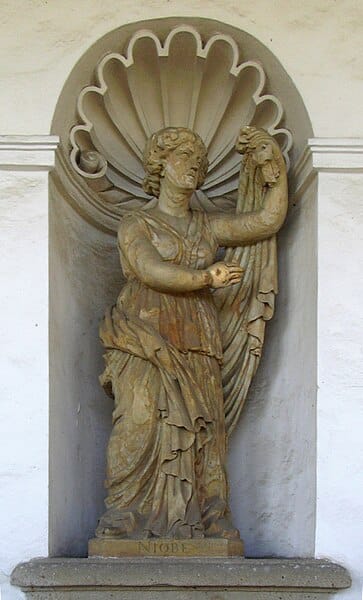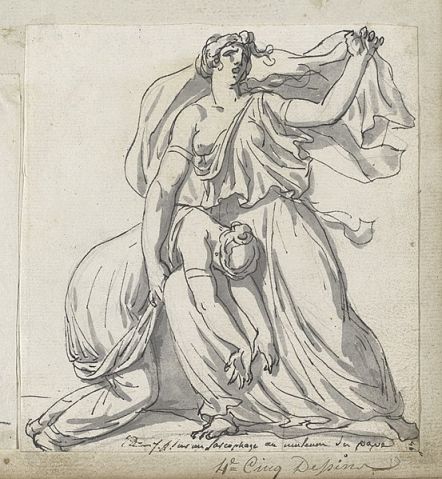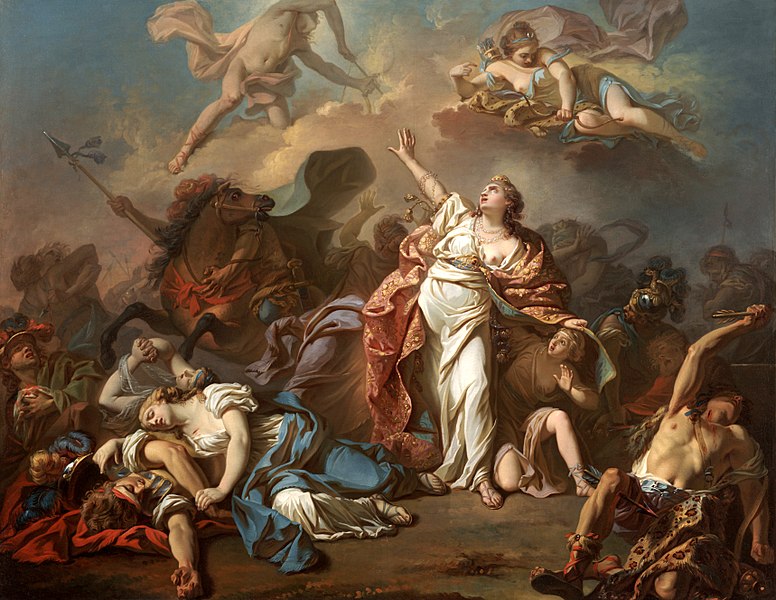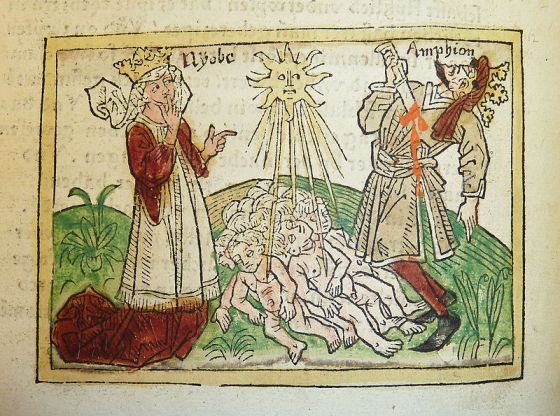Among all the Greek myths, few tales are as poignant as that of Niobe. A figure of both admiration and pity, her story serves as a timeless reminder of the dangers of excessive pride and the unpredictable wrath of the gods.
Niobe Key Facts
| Parents | Tantalus and Dione |
| Partners | Amphion |
| Siblings | Pelops and Broteas |
| Offspring | 14 children (7 sons and 7 daughters) |
| Other names | – |
| Roman name | Nioba |
| Best Known Myth | Mourning for her children slain by Apollo & Artemis |
Name and Etymology
The name “Niobe” is believed to have pre-Greek origins, though its exact etymology remains a subject of debate among scholars. Some suggest it might be related to the word “niobos,” meaning “mist” or “fog,” perhaps alluding to the tears she shed. In Roman mythology, she is referred to as “Nioba.” Throughout various texts and myths, she doesn’t carry many epithets, but her story alone has made her name synonymous with mourning and sorrow.

In ancient times, names often carried significant weight, encapsulating the essence of a person’s character or destiny. Niobe’s name, with its possible connections to mist and tears, seems almost prophetic given the heart-wrenching events of her life. Furthermore, her Roman counterpart, Nioba, is depicted in similar tales, underscoring the universality of her story.
Niobe’s Family and Relationships

Niobe was the daughter of Tantalus and Dione. Her father, Tantalus, was not just any mortal; he was a son of Zeus and enjoyed a special favor among the gods. This privilege allowed him to dine with the gods on Mount Olympus, a rare honor for a mortal. However, Tantalus’s relationship with the gods was marred by his own actions.
Dione, Niobe’s mother, is less prominently featured in myths but is often associated with divine origins. In some accounts, she’s considered a Titaness or even an early consort of Zeus before Hera.
Niobe’s siblings, Pelops and Broteas, had their own tales. The gods resurrected Pelops after they had been served him, and he soon emerged as a prominent figure in Greek mythology, subsequently naming the Peloponnese region after him. Meanwhile, Broteas showcased his exceptional hunting skills and reportedly carved the earliest image of the Great Mother Goddess, Cybele.
Niobe’s own narrative is deeply intertwined with her family’s legacy. Amphion, the king of Thebes, married Niobe, and together they had 14 children, paving the way for her sorrowful story. Just as her siblings and parents interacted with the divine, Niobe’s pride in her offspring directly caused her devastating fate. This tale offers a poignant reminder of the recurring cycle of pride and retribution that haunted her family.
Myths about Niobe
The myths surrounding Niobe are deeply interwoven with themes of pride, retribution, and profound sorrow. While various tales touch upon her life, the most poignant and enduring centers on the tragic loss of her children, a narrative that serves as a stark reminder of the perilous consequences of hubris when it challenges the divine.
The Tragic Boast and Divine Retribution
Niobe, basking in the joy of motherhood, was immensely proud of her 14 children – seven sons and seven daughters. This pride, however, soon took a darker turn. In a moment of overwhelming arrogance, she boasted of her progeny, claiming superiority over Leto, the Titaness mother of the twin deities Apollo and Artemis. Niobe’s words were not just a mere comparison; they were a direct challenge. She taunted the gods, questioning why Leto was honored more than her when the Titaness had only two children compared to her own fourteen.
In the world of Greek mythology, where the distinction between mortals and gods held great significance, the gods didn’t take such a boast lightly. Feeling deeply offended by this slight, Leto summoned her children, Apollo and Artemis. Recognized for their exceptional archery skills, the twins swiftly descended upon Thebes. Their primary mission? To punish Niobe for her insolence.
The ensuing events were nothing short of catastrophic. Apollo, with his golden bow, targeted Niobe’s sons, striking them down one after the other. Artemis, not to be outdone, turned her arrows upon Niobe’s daughters, ensuring that each met a similarly tragic fate. The streets of Thebes were awash with the blood of Niobe’s lineage, and the air was thick with the cries of a mother’s despair.
Niobe’s Unending Grief
After experiencing this divine punishment, Niobe felt an overwhelming grief. Realizing her own role in the tragedy added to the weight of her loss. Consequently, she roamed the streets of Thebes, now merely a shadow of her former self, and her cries loudly reflected her shattered heart.
Seeking solace and an escape from the prying eyes of those who once admired her, Niobe fled to Mount Sipylus. Here, in her anguish, she implored the gods for mercy. Whether it was a final act of retribution or a merciful release, the gods answered her plea. Niobe turned into a stone statue, forever capturing her moment of grief. However, her sorrow remained so deep that the statue shed endless tears. Consequently, these tears created a stream at the mountain’s base.
Depiction And Characteristics
Niobe’s appearance in myths doesn’t delve deeply into her physical attributes. However, her portrayal is often that of a regal, dignified woman, befitting her status as a queen. The overwhelming sorrow she embodies is a defining characteristic, making her a figure of both admiration and pity.
Symbols directly associated with Niobe are few. However, the stone statue on Mount Sipylus, perpetually weeping, stands as a poignant reminder of her tale. Her story is so powerful that the mere mention of her name evokes images of a grieving mother.
Representations Of Niobe In Art
The tragedy of Niobe has inspired countless artists throughout history. One of the most famous depictions is the “Niobe Group,” a set of Roman marble statues discovered in Rome. They are believed to be a copy of an earlier Greek work. These statues poignantly capture the moment of Apollo and Artemis’ wrath, with Niobe trying to shield her youngest daughter.

Another notable artwork is “The Tears of Niobe” by Jacques-Louis David, which beautifully captures her anguish. Throughout the Renaissance and beyond, Niobe’s story was a popular subject. Seen to symbolize the raw emotions of grief and the consequences of hubris.
Mentions in Ancient Texts
Niobe’s heart-wrenching tale has resonated through the ages, finding mentions in a myriad of ancient works. These texts, penned by some of the most illustrious authors of antiquity, underscore the enduring impact of her story.
Homer’s Iliad (c. 8th century BC)
Homer, the legendary Greek poet often dubbed the “father of Western literature,” briefly alludes to Niobe in his epic, the “Iliad.” In this monumental work that chronicles the Trojan War, Niobe’s ceaseless mourning is paralleled with Achilles’ grief over the death of Patroclus. A poignant line reads: “Like Niobe, who in her rocky tomb mourned her slain children.”
Ovid’s Metamorphoses (8 AD)
Ovid, a Roman poet known for his rich narrative style, provides an in-depth account of Niobe’s story in “Metamorphoses.” This collection of myths aimed to chronicle the world’s transformation from its creation to the deification of Julius Caesar. Ovid’s portrayal of Niobe is both vivid and evocative, as evidenced by the excerpt: “Though turned to stone, she wept.”
Sophocles’ Antigone (c. 441 BC)
Sophocles, one of the three ancient Greek tragedians whose plays have survived, references Niobe in his tragedy “Antigone.” The titular character, Antigone, compares her own tragic fate to that of Niobe. She says, “For I have heard of one, somewhere in Phrygia, a guest of Sipylus, who pined on the hills in the form of a bird, the feathered dove; they say she was turned to stone by the will of the gods. Would that I could be by her side!”
Pausanias’ Description of Greece (c. 2nd century AD)
Pausanias, a Greek traveler and geographer of the 2nd century AD, wrote about Niobe in his work “Description of Greece.” This travelogue provides a detailed account of ancient Greece’s landmarks and myths. Speaking of Niobe, Pausanias notes: “On the way from Phrygia to Mount Sipylus, one can see the stone, which they say Niobe was turned into after her children’s death.”
Frequently Asked Questions
Niobe boasted about having more children than Leto, the mother of Apollo and Artemis. This pride angered the gods, leading them to punish her by killing her offspring.
The statue is said to be on Mount Sipylus in modern-day Turkey, where she is believed to have been turned into stone.
She had 14 children – seven sons and seven daughters.
Her tale serves as a cautionary story about the dangers of excessive pride, especially when it challenges or mocks the gods.
Featured Image Credit: Jacques-Louis David, Public domain, via Wikimedia Commons

